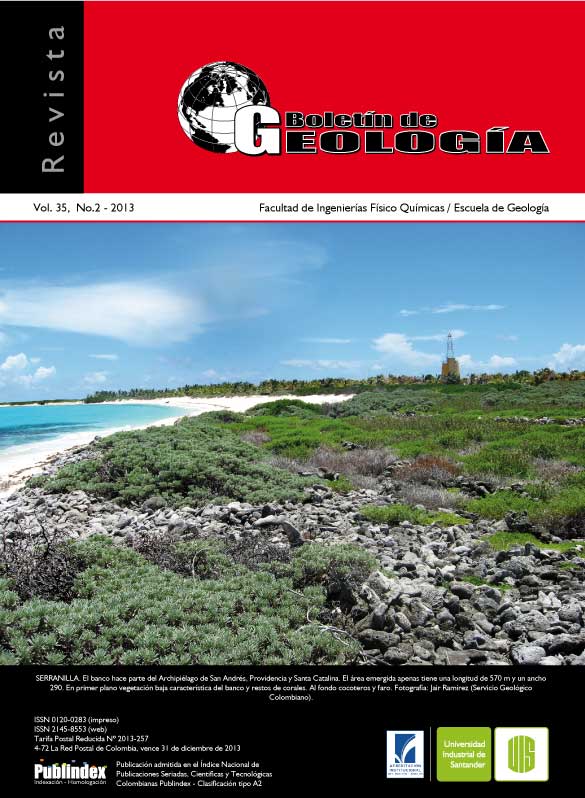PETROLOGY AND GEOCHEMISTRY OF THE VOLCANIC ROCKS OF CERRO LA TETA AND JURAREIN CREEK, HIGH GUAJIRA - COLOMBIA
Published 2013-12-12
Keywords
- Rhyolite,
- Cerro La Teta,
- Petrography,
- , Geochemistry,
- Calc-alkaline
- Guajira ...More
How to Cite
Abstract
This work aims to provide new analytical data, complementing the existing information about the Jurassic volcanic rocks of Cerro La Teta and Jurarein creek in the high area of la Guajira. A Geochemical characterization for three field samples collected in the area was made; major, minor and trace elements were analyzed, indicating a sub alkaline affinity from calc-alkaline series using characterization diagrams for volcanic rocks.
The chondritic normalized diagrams show abundance of light rare earth elements (LREE) (La/Yb)N of 6,38 – 37,17 and of (La/Ce)N of 1,31 - 1,35 instead of heavy rare earth elements (HREE) (Gd/Yb)N of 1,15 – 1,35.
Geotectonic diagrams suggest that these rocks were formed in a collisional environment, with a calc-alkaline affinity. Analyzing these data we can suggest that during the generation of the volcanic rhyodacite of the Cerro La Teta, the Colombian Guajira Peninsula was in a more southwestern position than the proposed by Kennan and Pindell (2009), closer to Farallon Plate subduction zone.
Downloads
References
Gill, J.B. 1981. Orogenic Andesites and Plate Tectonics. Springer. Berlín, 336p.
Hastie, A.R., Kerr, A.C., Pearce, J.A, and Mitchell, S.F. 2007. Classification of altered volcanic island arc rocks using immobile trace elements: development of the Th-Co discrimination diagram. Journal of Petrology, 48: 2341- 2357.
Irvine, T.N. and Baragar,W.R.A. 1971. A guide to the chemical classification of the common volcanic rocks. Canadian Journal of Earth Sciences, 8: 523-548.
Irving, E.M, 1972. Mapa geológico de la península de La Guajira, Colombia (Compilación): Escala 1:100.000.Kennan, L. and Pindell, J.L. 2009. Dextral shear, terrane accretion and basin formation in the Northen Andes: best explained by interaction with a pacific-derived Caribbean Plate. World Wide Web Address: http://www.tectonicanalysis.com/site/download/Kennan_Pindell_2009_Northern_Andes_PREPRINT.pdf
Le Bas, M., Le Maitre, R., Streckeisen, A, and Zanettin, B. 1986. A chemical classification of volcanic rocks based on the total alkali–silica diagram. Journal of Petrology 27: 745-750
MacDonald, W.D. and Opdyke; N.D. 1972. Tectonic rotations suggested by paleomagnetic results from Northern Colombia, South America. Journal of Geophysical Research, 77 (29): 5720 – 5730.
McDonough, W.F, and Sun, S.S., 1995. The composition of the Earth, Chemical Geology, 120, 228p. Wide WebAddress: http://www.jgeosci.org/detail/jgeosci.020/refs/
Medina, P.A., Zuluaga, C.A., Pinilla, A., Ríos, P.A., Guerrero, N.M, y Martínez, A.M. 2009. Departamento de Geociencias, Universidad Nacional de Colombia, Bogotá. http://www.ugr.es/~agcasco/igcp546/Colombia09/abstracts/Medina%20et%20al.pdf
Pindell, J.L, 1985. Alleghenan reconstruction and subsequent evolution of the Gulf of Mexico, Bahamas, and Proto-Caribbean: Tectonics, 4 (1): 1-39.
Pindell, J.L, and Barrett, S.F, 1990. Geological evolution of the Caribbean region: a plate tectonic perspective, in Dengo, G., and Case, J. E., eds., Geology of North America, The Caribbean region. Volume H. Boulder, Colorado, geological Society of America, pp. 405-432
